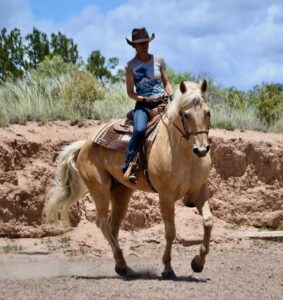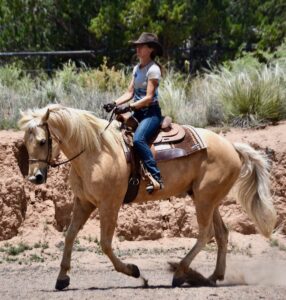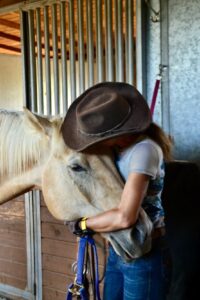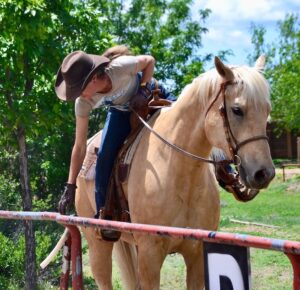 Editor’s Note: Best Horse Practices Summit presenter Katrin Silva grew up riding dressage in Germany before moving to the United States at age 19 to learn to ride Western. She’s been riding both disciplines for the last 20 years and is a regular guest columnist for Cayuse Communications. The author of Dressage for All of Us: How to Help Any Horse Become a Happier, More Responsive Riding Partner and the forthcoming Ride with Feel: A Guide for the Rest of Us lives in New Mexico where she works with dressage and Western clients.
Editor’s Note: Best Horse Practices Summit presenter Katrin Silva grew up riding dressage in Germany before moving to the United States at age 19 to learn to ride Western. She’s been riding both disciplines for the last 20 years and is a regular guest columnist for Cayuse Communications. The author of Dressage for All of Us: How to Help Any Horse Become a Happier, More Responsive Riding Partner and the forthcoming Ride with Feel: A Guide for the Rest of Us lives in New Mexico where she works with dressage and Western clients.
Katrin Silva writes:
When I started my horse training career, I apprenticed with professionals who did well in the show ring. In those days, in that competitive world, the standard definition of a good trainer was a winning trainer – someone whose horses did exactly what the judge wanted to see. Disobedient horses damaged a trainer’s reputation much more than shut down, exhausted, or drugged horses. Fighting and arguing with a horse was considered a normal, necessary part of the job. Neither my younger self nor most of the trainers I worked for would have admitted to being abusive, but when I look back, I can see that they – and I – crossed that line many times.
 I am not proud of these experiences. It took me way too long to start questioning what I was taught. It took me even longer to decide I did not want to be that kind of trainer, ever. On the other hand, I learned some valuable lessons I’ll carry with me until the day I ride into my final sunset. The most important one of these is that a disobedient horse is not resisting me out of spite or meanness. When a horse does not do what I am asking, I have a choice: I can take it personally and become discouraged. I can insist on obedience and pick a fight, which will only teach him to fight harder. Or, I can take the feedback he gives me and proceed from there, in a constructive direction:
I am not proud of these experiences. It took me way too long to start questioning what I was taught. It took me even longer to decide I did not want to be that kind of trainer, ever. On the other hand, I learned some valuable lessons I’ll carry with me until the day I ride into my final sunset. The most important one of these is that a disobedient horse is not resisting me out of spite or meanness. When a horse does not do what I am asking, I have a choice: I can take it personally and become discouraged. I can insist on obedience and pick a fight, which will only teach him to fight harder. Or, I can take the feedback he gives me and proceed from there, in a constructive direction:
Did he not do what I was asking because I asked him in a way that made no sense to him?
The first thing I do when a horse is disobedient is to check my own position and timing. When I’m sitting crooked, my aids for lateral work will not be clear. If I’m asking for a transition at the wrong moment, it won’t be prompt or smooth. Horses are incredibly sensitive creatures, but they are not mind readers. It’s my responsibility to sit centered and still, able to give clear, precise aids at the right moment.
Did he not do what I was asking because he did not understand what I wanted him to do?
 If so, I will spend more time on the basics. I will break my ask down into smaller pieces. I will go back to the building blocks of what I was asking, confirming each one before I put them back together. For example, before I ask for a flying change, I will work on the counter canter, the lateral work in the canter, the walk-canter-walk transition, and the simple changes. Once these are easy for the horse, I can start playing with flying changes. This is what I love most about the training scale of dressage: it’s essentially a flow chart for troubleshooting.
If so, I will spend more time on the basics. I will break my ask down into smaller pieces. I will go back to the building blocks of what I was asking, confirming each one before I put them back together. For example, before I ask for a flying change, I will work on the counter canter, the lateral work in the canter, the walk-canter-walk transition, and the simple changes. Once these are easy for the horse, I can start playing with flying changes. This is what I love most about the training scale of dressage: it’s essentially a flow chart for troubleshooting.
Did he not do what I was asking because he was not in the right frame of mind?
Was he distracted, tense, scared, bored, or tired? If so, what can I do to help him relax and/or focus? Sometimes, a quick correction is the right answer. Other times, quitting for the day or going on a trail loop on a loose rein are more appropriate options.
Did he not do what I was asking because he is not yet physically strong or balanced enough to do it?
If so, it’s my job to build the strength, balance, and straightness he needs, through appropriate exercises.
Did he not do what I was asking because he lacks confidence or trust in me?
If so, I need to build or re-build his confidence through being patient, consistent, and calm – not just right now, but always, in every interaction with my horse, or with any horse.

Horses never disobey because they want to annoy or upset us. It’s not in their nature. It’s in our nature to interpret their behavior that way, but this won’t get us anywhere. It’s easy to get stuck in mindless repetition of an exercise the horse just won’t get right. It’s easy to get stuck in the purgatory of frustration or self-blame. It’s easy to backslide instead of making progress with your horse. The only forward way out is a deep breath or two, some reflection, and, often, a change of plans or expectations.
Easier said than done, but our horses will teach us if we let them. They will present us with the same problem, over and over, until we are ready to hear what they try to tell us. Then, and only then, will we get unstuck.
As I was reading I thought to come upon a question like, “Does he have a different choice or preference in mind than I?”
If two roads diverge in a wood Bandit may choose the road less traveled, perhaps smelling deer that way. I sense neither fear nor confusion in him. I know that I will get clotheslined so I ask for the other track. Thus we have a disagreement.
Someone wrote a postscript to one of Mark Rashid’s chapters that ended with, “Sometimes my horse gets a vote.” I like that idea since it builds communication both directions. But it allows the horse to not “Do what I want” because sometimes he is telling me what he wants.
I wonder how this strikes those of you in the more… “controlled” (?) riding disciplines.